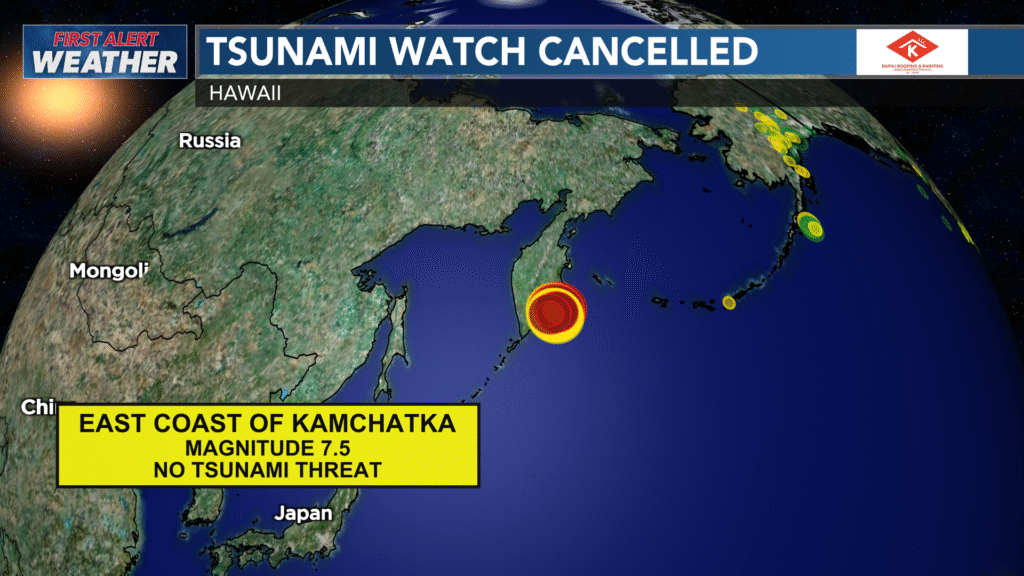Pacific Tsunami Warning Center Lifts Alert Following Kamchatka Peninsula Earthquake
A tsunami watch issued for the state of Hawaii has been canceled after emergency officials determined there was no threat to the islands following a powerful 7.5 magnitude earthquake off Russia’s Kamchatka Peninsula coast. The watch was issued at 9:03 p.m. and canceled at 9:42 p.m. after the Pacific Tsunami Warning Center determined that, based on all available data, there was no tsunami threat to Hawaii.
Breaking News: Russia Earthquake Triggers Brief Alert
The earthquake struck at 8:49 p.m. HST on Saturday, July 19, 2025, off the east coast of Russia. The significant seismic event initially prompted concerns that it could generate tsunami waves capable of reaching Hawaiian shores, leading to the precautionary tsunami watch.
Emergency officials had initially warned that if tsunami waves were to impact Hawaii, the estimated earliest arrival of the first tsunami wave would have been 2:43 a.m. HST on Sunday, July 20th. However, subsequent analysis of seismic data and ocean monitoring confirmed no tsunami threat materialized.
BREAKING: A magnitude 7.5 #earthquake in Russia's Kamchatka Peninsula may have triggered a #tsunami that could arrive in Hawaii around 2:43 a.m. HST.
— Matthew Cappucci (@MatthewCappucci) July 20, 2025
Magnitude unclear – could be several feet if a tsunami occurs.
Move away from docks/piers, and move boats past 180' depth. pic.twitter.com/xZbS1t6d77
Recent Alaska Earthquake Activity
This latest tsunami watch comes just days after another significant seismic event in the Pacific region. On July 16, 2025, a 7.3 magnitude earthquake struck near Sand Point, Alaska, initially prompting a tsunami warning from the National Weather Service that was later downgraded to an advisory.
The Alaska earthquake triggered NOAA’s National Tsunami Warning Center to issue tsunami warnings for the immediate Alaska coastline from Kennedy Entrance to Unimak Pass, including all of Kodiak Island, Chignik and Cold Bay. These warnings were subsequently canceled when the threat subsided.
Understanding Tsunami Watch vs Warning Systems
The Pacific Tsunami Warning Center operates a sophisticated alert system designed to protect coastal communities across the Pacific Ocean. A tsunami watch indicates that a significant distant earthquake has occurred and tsunami generation is possible, but not yet confirmed. This differs from a tsunami warning, which is issued when a tsunami has been confirmed and immediate evacuation may be required.
The Pacific Tsunami Warning Center’s final message stated: “Based on all available data there is no tsunami threat to the state of Hawaii… Therefore, the tsunami watch for Hawaii is now canceled. This will be the final message”.

Hawaii’s Tsunami Preparedness Measures
Hawaii maintains one of the world’s most comprehensive tsunami warning systems due to its vulnerable position in the Pacific Ocean. The state’s emergency management agencies work closely with the Pacific Tsunami Warning Center to monitor seismic activity and ocean conditions around the clock.
The islands’ preparedness includes an extensive network of warning sirens, evacuation zones, and public education programs. Residents and visitors are regularly informed about evacuation procedures and safe zones to ensure rapid response when genuine threats occur.
Pacific Ring of Fire Activity
The recent earthquake activity highlights the ongoing seismic activity along the Pacific Ring of Fire, the horseshoe-shaped zone of earthquake and volcanic activity that surrounds the Pacific Ocean. This region experiences approximately 90% of the world’s earthquakes and contains 75% of the world’s active volcanoes.
Both the Russia and Alaska earthquakes occurred within this tectonically active region, where the movement of oceanic and continental plates creates conditions favorable for large seismic events.
Emergency Response and Public Safety
The swift cancellation of the Hawaii tsunami watch demonstrates the effectiveness of modern tsunami monitoring systems. Advanced seismic networks and ocean buoys provide real-time data that allows scientists to quickly assess tsunami generation potential and adjust threat levels accordingly.
Emergency management officials emphasize the importance of taking all tsunami watches and warnings seriously, even when they are subsequently canceled. The brief nature of Saturday’s watch reflects the rapid analysis capabilities of modern tsunami warning systems.
Conclusion
While Saturday’s tsunami watch for Hawaii was brief and ultimately canceled without incident, it serves as an important reminder of the Pacific region’s seismic activity and the critical importance of tsunami preparedness systems. The efficient response and quick resolution demonstrate the effectiveness of international tsunami monitoring networks in protecting coastal communities across the Pacific.
Stay informed about tsunami watches and warnings through official channels including NOAA’s Pacific Tsunami Warning Center and local emergency management agencies.
